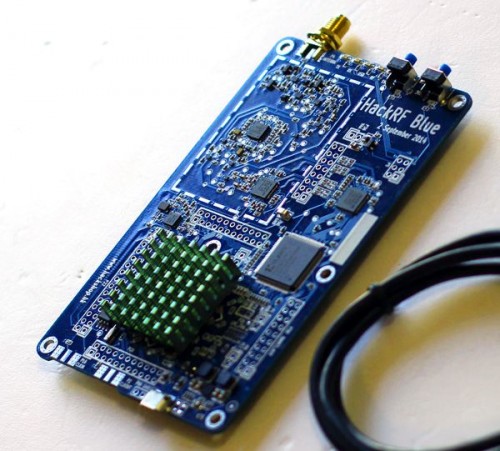HackRF Blue Shipped and HackRF One Updates
Back in December of last year we posted about the Indiegogo campaign for the HackRF Blue, a lower cost clone of the HackRF One software defined radio. They were able to achieve a lower cost by better component sourcing and manufacturing choices, thus reducing the cost from $299 to $200. The HackRF Blue Indiegogo campaign was successful and most of the HackRF Blue’s have now been shipped and delivered to backers. If you need help getting started with the HackRF Blue see http://hackrfblue.com/getting-started/. To get started on Windows, simply use Zadig like with the RTL-SDR, and use SDR# which has built in HackRF support.
The specs of the official HackRF One (and by extension the HackRF Blue) have also recently been changed. They now officially acknowledge that the HackRF One is capable of operating at a frequency down to about 1 MHz. They write:
Now that we’ve seen consistent low frequency performance across multiple manufacturing runs, we’re comfortable changing the official specification: HackRF One operates from 1 MHz to 6 GHz. Try attaching a long wire antenna to listen to shortwave radio!
Recently some people have been considering which mid priced SDR to upgrade to from their RTL-SDR. Our opinion is this: The HackRF has pretty poor RX performance, probably the same as, or even worse than the RTL-SDR, so we suggest you buy it only if you want TX capabilities or need operation above 1.7 – 2 GHz. If you only need RX then we suggest you choose the Airspy or SDRPlay as they have much better RX performance. See our list of SDRs for more possible options.

HDSDR FANS: There is now a functional Extio DLL for Hack RF here: https://github.com/jocover/ExtIO_HackRF/releases
Poor Rx performance? I’d say the overall design has gone for frequency range, rather than sensitivity.
I tried my new HackRF Blue out with an internal random wire, draped up over a curtain rod. The target:Radio Thailand on 9390kHz [I’m in Adelaide, Australia – 6900 km range]
On the HackRF, signal was barely discernable. Maybe I’n too new, but all my fiddling with amp settings etc. in SDR Sharp failed to bring in an understandable signal. I switched to my little Tecsun PL-390 and there was an immediate, noticeable improvement. Voices were faint, but distinct.
Does that make the Tecsun “better”? Only if you never go outside the HF bands…
The HackRF is more an infosec security auditing, and penetration, tool than a high sensitivity RF receiver. But with a bank of narrow band filters it could be an OK receiver. The problem is that it only has two filters, a low pass filter up to 2.3GHz and high pass filter from 2.7GHz up. With such large windows a lot of signals that you have no interest in will enter and will interfere with, or add noise to, the signal that you do have an interest in.